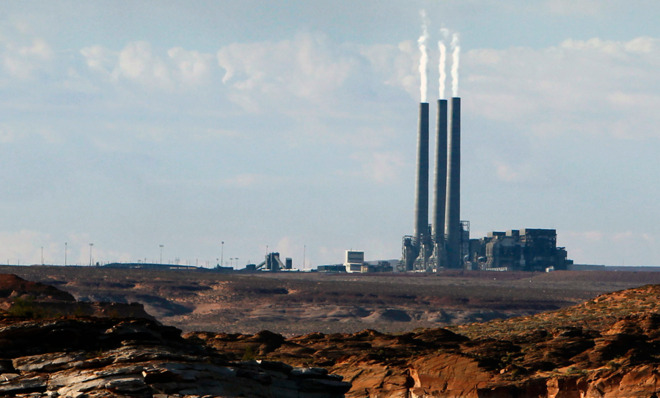Could conservatives pull a Halbig on the EPA?
If their latest foray into typo hunting is any indication, they will probably try


The recent court decision Halbig v. Burwell — in which a three-judge panel struck down an important provision of the Affordable Care Act — was a glorious victory for conservative typo hounds. They went over the ACA with a fine-toothed comb looking for ways to damage the policy and got part of the D.C. Circuit Court of Appeals to agree with their reasoning.
Could conservatives repeat that tactic with other laws? Josiah Neeley recently made the case here at The Week, arguing that because of a drafting error in amendments to the Clean Air Act, the EPA's proposed rules on coal-fired power plants could be overturned:
Ordinarily, when the House and Senate pass different versions of the same bill, any discrepancies are reconciled by a Conference Committee. In this case, however, the Committee was asleep at the switch, and included both the House and Senate amendments to the language in the final bill. Since the two versions of the language are inconsistent, this has created a bit of a statutory puzzle. The U.S. Code includes the House language. The EPA, by contrast, has long maintained that the Senate language is what governs.
This matters, because under the House language, the EPA's Clean Power Plan would be illegal, since the EPA has already issued regulations under 112 of the same "source category" as the existing power plants covered in the new rule. [The Week]
But after speaking with several legal experts, I think the EPA is probably safe. There are two main defenses.
The Week
Escape your echo chamber. Get the facts behind the news, plus analysis from multiple perspectives.

Sign up for The Week's Free Newsletters
From our morning news briefing to a weekly Good News Newsletter, get the best of The Week delivered directly to your inbox.
From our morning news briefing to a weekly Good News Newsletter, get the best of The Week delivered directly to your inbox.
First is the Chevron standard. Ambiguous language is fairly common in U.S. law, so the Supreme Court, in the case Chevron vs. NRDC, established a method of resolving such discrepancies. Under Chevron, if there is some ambiguity in the language of the statute, courts must determine whether an agency's actions are based on a reasonable interpretation. If they are, then the courts must defer to the agency in question.
The U.S. Code contains only the House version of the bill. But the "Statutes at Large," which is the ultimate authority, contains both. Thus, there is a strong argument that the EPA deserves Chevron deference in this instance. This isn't a case of language that can be read in two different ways — it's literally two different versions of the paragraph. A more obvious case of statutory ambiguity would be hard to imagine.
Second, it's not at all clear that the House language would, in fact, close off regulation of carbon pollution from coal-fired power plants. Here is the language in question, from section 111(d):
…each State shall submit to the Administrator a plan which (A) establishes standards of performance for any existing source for any air pollutant
(i) for which air quality criteria have not been issued or which is not included on a list published under section 7408(a) or emitted from a source category which is regulated under section 7412 of this title, but
(ii) to which a standard of performance under this section would apply if such existing source were a new source.
Neeley says this clause was explicitly designed to forbid dual regulation of emission sources. The idea is that because the statute says states have to submit a plan for sources of air pollutants that haven't been regulated, then any sources of pollutants that have been regulated for anything else at all are off limits.
A free daily email with the biggest news stories of the day – and the best features from TheWeek.com
Indeed, a recent lawsuit from 12 state attorneys general argues that because coal-fired power plants are already regulated for mercury emissions under section 112 (the 7412 reference above), their carbon dioxide emissions can't be regulated.
But that is a huge logical leap. After all, the section doesn't say, "The EPA shall not regulate pollution sources already regulated elsewhere." One can also read it as filling a regulatory gap — making sure that air pollutants that don't fit under section 109, 110, or 112 (which define more traditional sources of pollution, like smog or cancer-causing agents) may also be regulated. In this view, section 111(d) forbids only dual regulation of particular pollutants, not sources in general.
This interpretation fits much better with the broader context of the Clean Air Act (and is how the Senate version reads). Forbidding dual regulation of sources would practically gut the bill's authority to regulate carbon dioxide at all, since just about all of the major sources have already been subject to some other regulation. "There is no actual indication that the House was trying to do a different thing than the Senate," says James Wrathall, counsel at Sullivan & Worcester.
Such a view is also supported by Supreme Court rulings. In Massachusetts vs. EPA, the court held that carbon dioxide and other greenhouse gases are indeed air pollutants, and that the EPA is obliged to regulate them. In American Electric Power Company vs. Connecticut, the court ruled that private power companies can't be sued for carbon dioxide emissions as a public nuisance, because the EPA is responsible for regulating those emissions. Both of those rulings make no sense if section 111(d) effectively forbids any regulation of carbon emissions from sources otherwise regulated.
Most striking of all, the argument by the attorneys general would make a total hash of the most recent Supreme Court ruling on EPA greenhouse gas regulations, Utility Air Regulation Group vs. EPA, which was handed down only a few weeks back. The ruling held that the agency could regulate large, stationary sources of greenhouse gases only if they are already regulated for emitting conventional pollutants.
In any case, the first round of lawsuits against the EPA will almost certainly be thrown out because the EPA hasn't even issued its final rule.
If this latest effort to secure conservative policy goals through the courts is going to be anything more than a nuisance to the EPA, conservatives are going to have to come up with something much stronger.
Ryan Cooper is a national correspondent at TheWeek.com. His work has appeared in the Washington Monthly, The New Republic, and the Washington Post.
-
 Bari Weiss’ ‘60 Minutes’ scandal is about more than one report
Bari Weiss’ ‘60 Minutes’ scandal is about more than one reportIN THE SPOTLIGHT By blocking an approved segment on a controversial prison holding US deportees in El Salvador, the editor-in-chief of CBS News has become the main story
-
 Has Zohran Mamdani shown the Democrats how to win again?
Has Zohran Mamdani shown the Democrats how to win again?Today’s Big Question New York City mayoral election touted as victory for left-wing populists but moderate centrist wins elsewhere present more complex path for Democratic Party
-
 Millions turn out for anti-Trump ‘No Kings’ rallies
Millions turn out for anti-Trump ‘No Kings’ ralliesSpeed Read An estimated 7 million people participated, 2 million more than at the first ‘No Kings’ protest in June
-
 Ghislaine Maxwell: angling for a Trump pardon
Ghislaine Maxwell: angling for a Trump pardonTalking Point Convicted sex trafficker's testimony could shed new light on president's links to Jeffrey Epstein
-
 The last words and final moments of 40 presidents
The last words and final moments of 40 presidentsThe Explainer Some are eloquent quotes worthy of the holders of the highest office in the nation, and others... aren't
-
 The JFK files: the truth at last?
The JFK files: the truth at last?In The Spotlight More than 64,000 previously classified documents relating the 1963 assassination of John F. Kennedy have been released by the Trump administration
-
 'Seriously, not literally': how should the world take Donald Trump?
'Seriously, not literally': how should the world take Donald Trump?Today's big question White House rhetoric and reality look likely to become increasingly blurred
-
 Will Trump's 'madman' strategy pay off?
Will Trump's 'madman' strategy pay off?Today's Big Question Incoming US president likes to seem unpredictable but, this time round, world leaders could be wise to his playbook


